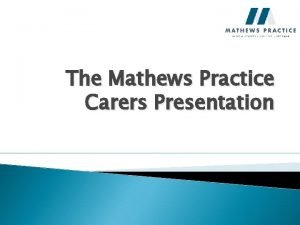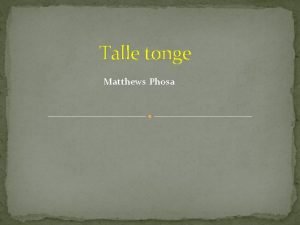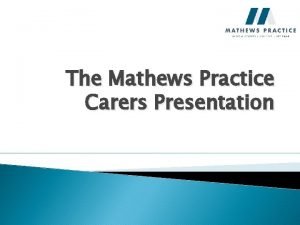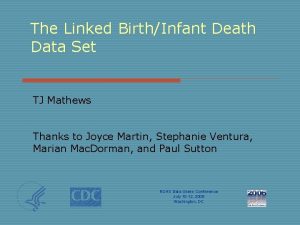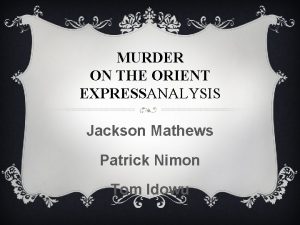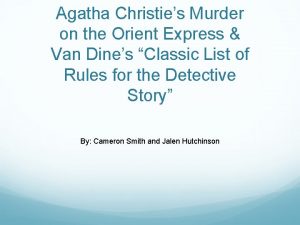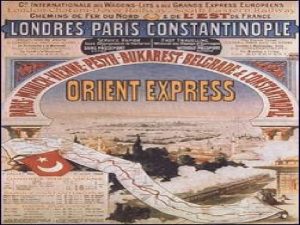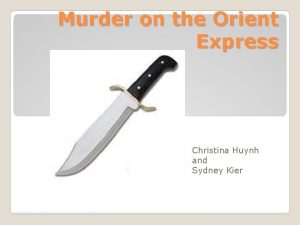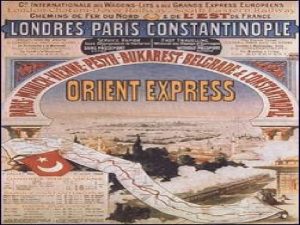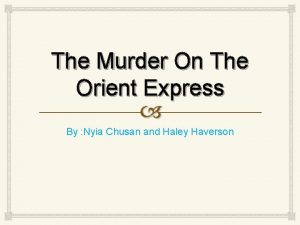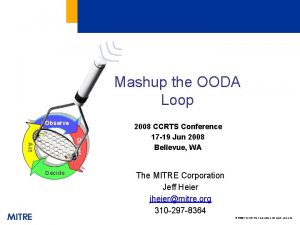MURDER ON THE ORIENT EXPRESS ANALYSIS Jackson Mathews




















- Slides: 20

MURDER ON THE ORIENT EXPRESS ANALYSIS Jackson Mathews Patrick Nimon Tom Idowu

VOCAB • Hymeneal: adj. of or pertaining to marriage Ex. My brother gave a hymeneal request to his girlfriend on Saturday. • Suffice: v. to be enough or adequate, as for needs or purposes Ex. No simpler flavor than chocolate will suffice to quench my icy hunger for a delicious dairy treat. • Expenditure: n. the act of spending something Ex. My expenditure should be more controlled if I want to purchase a new car. • Irremediably : adj. not admitting of remedy cure or repair Ex. I almost lost my mind when I irremediably cracked my i. Phone. • Culpability: adj. blameworthiness Ex. The culprit’s culpability was untested during the trial.

VOCAB CON. • Verisimilitude: n. appearance or resemblance of truth Ex. The verisimilitude of the criminal’s testimony was undeniably reasonable. • Delineation: n. a description Ex. The delineation of the protagonist was amusing. • Cavorting: v. prancing about Ex. The flamboyant man was cavorting • Hoodwink: v. to deceive or trick Ex. The man would always hoodwink his wife up until the messy divorce. • Ineptitude: n. quality or condition of being awkward, clumsy, or foolish Ex. My brother’s ineptitude was so apparent that he could never get a girlfriend.

VOCAB • CON. Ineptitude: n. quality or condition of being awkward, clumsy, or foolish Ex. My brother’s ineptitude was so apparent that he could never get a girlfriend. • Shouldered: v. to assume as a responsibility Ex. William Wallace shouldered the duty of the leader of the Scotts. • Commission: n. the act of committing or giving in charge Ex. The king put the knight into commission. • Indignation: n. strong displeasure at something considered unjust, offensive, or insulting Ex. My indignation of the election was so strong that I had to speak my mind. • Onus: n. a difficult or disagreeable obligation, task, burden, etc. Ex. Squidward was very displeased with the onus of taking out the trash.

VAN DINE'S 20 RULES 1: The reader should be given as many chances as the detective does to solve the mystery, and any type of clues should be clearly stated to be so. 2: The reader cannot be fooled in any way, except if the criminal is playing a trick on the detective. 3: The reader should not be distracted by pointless plots, such as a love story, where the reader is drawn into that plot and out of the main plot. 4: In NO circumstances can the detective himself be the guilty party. It is dishonest to the reader. 5: The criminal cannot be found by accident, it is cheap and a waste of the reader's time.

VAN DINE'S 20 RULES CONT. 6: A detective novel always has a detective. The detective gathers clues to reveal the criminal, and discovers who the criminal is by reaching a conclusion based on the clues he found. . 7: The crime must need to have a murder, which displays the height of all evils. 8: The crime must be solved by using brainpower and logic. 9: A detective novel can have one and only one detective solving the crime. 10: The criminal must be a somewhat significant character.

VAN DINE'S 20 RULES CONT. 11. A servant in the book cannot be found as the culprit or criminal, because it is found as a simple solution and easy answer to the mystery or case. The culprit must be one with the least suspicion, or someone who wouldn't normally be interpreted to be the victim. 12. There must always be one final victim in the story. There can be many murderers and(or) even crimes but there must always be one mastermind in charge of the whole murder mystery, and the reader must focus on an evil single act committed by the main culprit.

VAN DINE'S 20 RULES CONT. 13. Secret societies should have no place in a murder. The detective should not have a leaning post, but single-handedly portray himself to be capable to maturely accounting for the case he has approved of for himself. 14. All of the evidence collected must be rational, and realistic. The method that the detective comes up with the truth must be the same, as well as all aspects of the crime itself. The crime must not be unrealistic, or the author loses the reader to the realm of fantasy. 15: The truth of the problem must be apparent at all times throughout the mystery. The reader must be able to spot the explanation for the crime, and if possible, commit to solving the case before the final part of the story unfolds, but most often, the reader does not solve the mystery before the detective.

VAN DINE'S 20 RULES CONT. 16: There should be no unnecessary plot points, the plot should be about only the mystery, not the character's lives. 17: The guilty party cannot be a known criminal, such as a serial killer or famous burglar. The criminal must be someone unexpected, who is both a surprise and a plot twist to the reader. The criminal should never be bothered with crime, the police departments etc. are supposed to administer justice to the known victim. 18: The murder must be a murder, and not a suicide or accident. This would defeat the purpose of the mystery novel and in result, waste the reader's time.

VAN DINE'S 20 RULES CONT. 19: All the crimes in mystery novels should be personal, with no payed jobs. There can be no motivation from an type or war-related affairs. 20. Using cigarettes to determine a suspect identity, scaring a suspect into revealing himself, a forged fingerprint, dummy-figure alibis, dogs not barking revealing a familiar intruder, pinning the crime on a look-alike or relative, knockout medicine, committing a crime in a room the police have broken into, a word association test for guilt, and a coded letter, are all overused and unoriginal parts of a detective story.

RULE #3 "The Classic List of Rules for the Detective Story" "3. There must be no love interest. The business in hand is to bring a criminal to the bar of justice, no to bring a lovelorn couple to the hymeneal altar. " (Van Dine) Explanation: Agatha Christie disagrees with the Rule in Murder on the Orient Express through the usage of Mary Debenham and Colonel Arbuthnot. These two are very much the 'lovelorn couple' that Van Dine warns about. However, it is not a distraction to the story and only serves the purpose of entertaining the reader and adding a tint of longing to the result of the evidence, as the reader wishes that the couple could live happily ever after, when they, in fact, cannot. Murder on the Orient Express: "All these good and faithful- and poor Michel- and Mary and Colonel Arbuthnot- they love each other. . " (Christie 245)

RULE #4 "The Classic List of Rules for the Detective Story" "4. The detective himself, or one of the official investigators, should never turn out to be the culprit. This is bald trickery, on a par with offering someone a bright penny for a five-dollar gold piece. It's false pretenses. " (Van Dine) Explanation: Agatha Christie agrees with this rule in Murder on the Orient Express. The book would have been useless if Poirot had turned out to be the culprit. The excellent storytelling would have been useless in defence against the purposeless ending. If Christie had named Poirot the criminal, all of the clues and detective work up until that point would have been in vain and the only feeling the reader would be having is anger at the epic amount of wasted time they have stumbled upon. Murder on the Orient Express: "You know all about it, M. Poirot. You're a very wonderful man. But even you can't quite imagine what it was like- that awful day in New York. " (Christie 243)

RULE #17 "The Classic List of Rules for the Detective Story" "17. A professional criminal must never be shouldered with the guilt of a crime in a detective story. Crimes by housebreakers and bandits are the province of the police department- not of authors and brilliant ameteur detectives. A really fascinating crime is one committed by a pillar of a church, or a spinster noted for her charities" (Van Dine). Explanation: Christie's Murder on the Orient Express fits this rule in Van Dine's formula. The crime committed in the book is the murder of one man by twelve individuals. The victim, Cassetti, is a mobster and effectively killed their family, relatives, and friends in the Armstrong family. His killers were all of different age, ethnicity, and occupation. The one thing that ties them together is that their killing of Cassetti can be viewed as an act of justice. Murder on the Orient Express: Now, I will make clear to you this, my friend. Cassetti was the man! But by means of enormous wealth he had piled p, and owing to the secret hold he had over various persons, he was acquitted on some technical inaccuracy. Notwithstanding that, he would have been lynched by the populace had he not been clever enough to give them the slip. It is now clear to me what happened. He changed his name and left America. Since then he has been a gentleman of leisure, travelling abroad and living on his rentes. " (Christie 65)

RULE #15 "The Classic List of Rules for the Detective Story": "15. The truth of the problem must at all times be apparentprovided the reader is shrewd enough to see it. By this I mean that if the reader, after learning the explanation for the crime, should reread the book, he would see that the solution had, in a sense, been staring him in the face- that all the clues really pointed to the culprit- and that, if he had been as clever as the detective, he could have solved the mystery himself without going on to the final chapter. That the clever reader does often thus solve the problem goes without saying. " (Van Dine) Explanation: In Murder on the Orient Express, Mrs. Christie is very apparent in following the guidelines for this particular formula. From the beginning of the book, she starts spouting clues that all could help persuade your way of thinking. She always keeps you guessing until the truth is finally revealed, and when it is, you will wonder how you did not realize it earlier on. Murder on the Orient Express: "It is not pretty, someone must have stood there and stabbed him again and again. How many wounds are there exactly? " "I make it twelve. One or two are so slight as to be practically scratches. On the other hand, at least three would be capable of causing death. " (Chrisie 54)

RULE #10 "The Classic List Of Rules For The Detective Story. " "10. The culprit must turn out to be a person who has played a more or less prominent part in the story - that is, a person with whom the reader is familiar and in whom he takes an interest. " (Van Dine) Explanation: In Murder on the Orient Express, Agatha Christie protrudes into the reader's mind with a series on conniving events. The culprit is least expected at most points in the book, but Christie does a superb job of giving leadway to revealing, but yet not revealing who the culprit is. She makes a maze of conflicting resolutions which occur within the reader's mind until the culprit is caught against all odds. Murder On The Orient Express: "There remains Mrs. Hubbard. Now Mrs. Hubbard, let me say, played the most important part in the drama. By occupying the compartment communicating with that of Ratchett she was more open to suspicion than anyone else. In the nature of things she could not have an alibi to fall back upon. To play the part she played - the perfectly natural, slightly ridiculous American fond mother - an artist was indeed. But there was an artist connected with the Armstrong family: Mrs. Armstrong's mother - Linda Arden, the actress. . " (Christie 243)

RULE #19 "The Classic List Of Rules For The Detective Story. " "19. The motives for all crimes in detective stories should be personal. International plottings and war politics belong in a different category fiction - in secret-service tales, for instance. But a murder story must be kept gemutlich, so to speak. It must reflect the reader's everyday experiences, and give him a certain outlet for his own repressed desires and emotions. " (Van Dine) Explanation: In Murder On The Orient Express, Christie revolves the whole story about one interpersonal conflict between a family and a criminal. The case she brings up known as the Armstrong case in the book, shows how many individuals were affiliated with the Armstrong family. Throughout the book the Armstrong case keeps popping up within most of the character's lives. Christie takes the reader on an escalated journey because she wants the reader to be eager to find out how the victims of a personal conflict can resolve their situation. Murder On The Orient Express: "And then, Messieurs, I saw light. They were all in it. For so many people connected with the Armstrong case to be travelling by the same train through coincidence was not only unlikely: it was impossible. It must be not chance, but design. (Christie 238 -239)

RULE #18 "The Classic List Of Rules For The Detective Story. " "18. A crime in a detective story must never turn out to be an accident or suicide. To end an odyssey of sleuthing with such an anticlimax is to hoodwink the trusting and kind-hearted reader. " (Van Dine) Explanation: Christie reveals that the mystery of the story revolves around death and murder. She points it out several times during the plot. What makes Christie's The Murder On The Orient Express such a great book is that even in the midst of turmoil and death in an isolated scenario, a great detective can rise up and solve a murder situation at hand without much physical distress, emotional disorientation, and environmental prohibition. Murder On The Orient Express: "And now a passenger lies dead in his berth- stabbed. " (Christie 39)

RULE #12 "The Classic List Of Rules For The Detective Story. " "12. There must be one culprit, no matter how many murders are committed. The culprit may, of course, have a minor helper or co-plotter: but the entire onus must rest on one pair of shoulders: the entire indignation of the reader must be permitted to concentrate on a single black nature. (Van Dine) Explanation: Agatha Christie does not exactly follow this rule's formula precisely. Instead she adds her own twist to the story due to the relevance of the of an interpersonal case: The Armstrong case. Now meaning that since the case revolves around personal justice and family affairs, anything within the realm of the family's conflicts can conclude to more than one murderers. Murder On The Orient Express: "'Well, ' she said, 'you know everything now, M. Poirot. What are you going to do about it? If it must all come out =, can't you lay the blame upon me and me only? " (Christie 244 -245)

QUESTION &ANSWER Question: Does Murder On The Orient Express fit in with the pattern for whodunits laid out by Van Dine? Answer: For the most part, Murder on the Orient Express generally does fit in with the formula for detective stories according to S. S. Van Dine's "Twenty Rules for Writing Detective Stories", with a few exceptions. Van Dine has laid out an extremely clear and detailed formula to writing a brilliantly clever detective novel. These steps combined with Christie's superfluous way of writing mix together to concoct a simply flawless piece of work. In many ways, however, Christie does not follow the rules laid out handsomely by Van Dine. For instance, Van Dine lays out a whole rule describing the fact that there should never be a love interest involved in the case, as it distracts the reader from the main point in the novel. Christie goes against this in Murder on the Orient Express by the inclusion of Mary Debenham and the Colonel. On the other hand, Christie follows to a point, other rules such as the detective never being the culprit or the culprit being discovered through logical deductions are not on accident. Christie most likely valued Van Dines rules. Her competence to follow the rules at her own pace and still interweave her own characteristics of writing is simply phenomenal. The way she executed The Murder On The Orient Express, is not to be challenged, because of her unique style of writing, this book truly shows her complex ability to follow simple rules yet create her own intricate piece of writing. She is truly an adorned and famed author, one to be admired for ages.

WORKS CITED Murder On The Orient Express: Christie, Agatha. Murder on the Orient Express. Toronto: Bantam, 1983. Print. S. S. Van Dine's Article: Dine, S. S. Van. "The Classic List of Rules for the Detective Story. " American Magazine Sept. 1928: n. pag. Web.
 Murder on the orient express vocabulary
Murder on the orient express vocabulary Murder on the orient express vocabulary
Murder on the orient express vocabulary Orientekspressen
Orientekspressen Outsiders plot diagram
Outsiders plot diagram Talle tonge mathews phosa
Talle tonge mathews phosa Mathews v eldridge test
Mathews v eldridge test Cherry valance thoughts about inner self
Cherry valance thoughts about inner self Mathews practice
Mathews practice The mathews practice
The mathews practice Roy matthews bainbridge high school
Roy matthews bainbridge high school Talle tonge
Talle tonge Tu cliques
Tu cliques Mathews practice
Mathews practice Tj mathews
Tj mathews Tiffany mathews
Tiffany mathews Erin ledbetter
Erin ledbetter Elizabeth mathews
Elizabeth mathews Orient ezan cihazı
Orient ezan cihazı Spur land nav
Spur land nav How to orient a map using a lensatic compass
How to orient a map using a lensatic compass Elalog
Elalog







